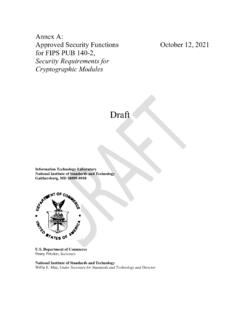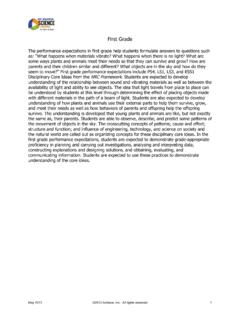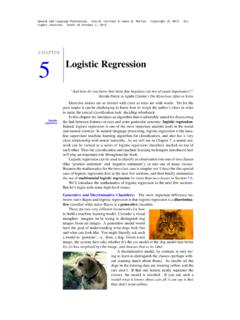Transcription of introduction to spiking neural networks: information ...
1 Review Acta Neurobiol Exp 2011, 71: 409 433 2011 by Polish Neuroscience Society - PTBUN, Nencki Institute of Experimental Biology introductionSpiking neural networks (SNN) represent a special class of artificial neural networks (ANN), where neu-ron models communicate by sequences of spikes. Networks composed of spiking neurons are able to process substantial amount of data using a relatively small number of spikes (VanRullen et al. 2005). Due to their functional similarity to biological neurons, spik-ing models provide powerful tools for analysis of ele-mentary processes in the brain, including neural infor-mation processing , plasticity and learning.
2 At the same time spiking networks offer solutions to a broad range of specific problems in applied engineering, such as fast signal- processing , event detection, classification, speech recognition, spatial navigation or motor control. It has been demonstrated that SNN can be applied not only to all problems solvable by non- spiking neural networks, but that spiking models are in fact computa-tionally more powerful than perceptrons and sigmoidal gates (Maass 1997). Due to all these reasons SNN are the subject of constantly growing interest of this paper we introduce and discuss basic con-cepts related to the theory of spiking neuron models.
3 Our focus is on mechanisms of spike-based informa-tion processing , adaptation and learning. We survey various synaptic plasticity rules used in SNN and dis-cuss their properties in the context of the classical categories of machine learning, that is: supervised, unsupervised and reinforcement learning. We also present an overview of successful applications of spik-ing neurons to various fields, ranging from neurobiol-ogy to engineering. Our paper is supplemented with a comprehensive list of pointers to literature on spiking neural aim of our work is to introduce spiking neural networks to the broader scientific community.
4 We believe the paper will be useful for researchers work-ing in the field of machine learning and interested in biomimetic neural algorithms for fast information pro-cessing and learning. Our work will provide them with a survey of such mechanisms and examples of applica-tions where they have been used. Similarly, neurosci-entists with a biological background may find the introduction to spiking neural networks: information processing , learning and applicationsfilip ponulak1,2* and Andrzej Kasi ski11 Institute of Control and information Engineering, Poznan University of Technology, Poznan, Poland, *Email.
5 2 Princeton Neuroscience Institute and Department of Molecular Biology, Princeton University, Princeton, USAThe concept that neural information is encoded in the firing rate of neurons has been the dominant paradigm in neurobiology for many years. This paradigm has also been adopted by the theory of artificial neural networks. Recent physiological experiments demonstrate, however, that in many parts of the nervous system, neural code is founded on the timing of individual action potentials. This finding has given rise to the emergence of a new class of neural models, called spiking neural networks.
6 In this paper we summarize basic properties of spiking neurons and spiking networks. Our focus is, specifically, on models of spike-based information coding, synaptic plasticity and learning. We also survey real-life applications of spiking models. The paper is meant to be an introduction to spiking neural networks for scientists from various disciplines interested in spike-based neural words: neural code, neural information processing , reinforcement learning, spiking neural networks, supervised learning, synaptic plasticity, unsupervised learning Correspondence should be addressed to F.
7 Ponulak Email: 27 May 2010, accepted 20 June 2011410 F. Ponulak and A. Kasinski paper useful for understanding biological learning in the context of machine learning theory. Finally, this paper will serve as an introduction to the theory and practice of spiking neural networks for all researchers interested in understanding the principles of spike-based neural modeLsBiological neurons communicate by generating and propagating electrical pulses called action potentials or spikes (du Bois-Reymond 1848, Schuetze 1983, Kandel et al.)
8 1991). This feature of real neurons became a cen-tral paradigm of a theory of spiking neural models. From the conceptual point of view, all spiking models share the following common properties with their bio-logical counterparts: (1) They process information coming from many inputs and produce single spiking output signals; (2) Their probability of firing (generat-ing a spike) is increased by excitatory inputs and decreased by inhibitory inputs; (3) Their dynamics is characterized by at least one state variable; when the internal variables of the model reach a certain state, the model is supposed to generate one or mores basic assumption underlying the implementa-tion of most of spiking neuron models is that it is tim-ing of spikes rather than the specific shape of spikes that carries neural information (Gerstner and Kistler 2002b).
9 In mathematical terms a sequence of the firing times - a spike train - can be described as S(t)= f (t-tf), where f = 1, 2, .. is the label of the spike and (.) is a Dirac function with (t) 0 for t=0 and - (t)dt = 1. Historically the most common spiking neuron mod-els are Integrate-and-Fire (IF) and Leaky-Integrate-and-Fire (LIF) units (Lapicque 1907, Stein 1967, Gerstner and Kistler 2002b). Both models treat bio-logical neurons as point dynamical systems. Accordingly, the properties of biological neurons related to their spatial structure are neglected in the models.
10 The dynamics of the LIF unit is described by the following formula:(1) where u(t) is the model state variable (corresponding to the neural membrane potential), C is the membrane capacitance, R is the input resistance, io(t) is the exter-nal current driving the neural state, ij(t) is the input current from the j-th synaptic input, and wj represents the strength of the j-th synapse. For R , formula (1) describes the IF model. In both, IF and LIF models, a neuron is supposed to fire a spike at time tf , whenever the membrane potential u reaches a certain value called a firing threshold.





